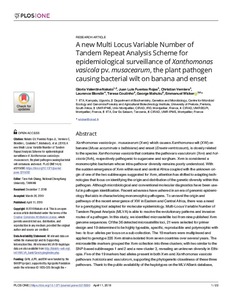| dc.contributor.author | Nakato, G.V. |
| dc.contributor.author | Rojas, J.L.F. |
| dc.contributor.author | Verniere, C. |
| dc.contributor.author | Blondin, L. |
| dc.contributor.author | Coutinho, T. |
| dc.contributor.author | Mahuku, G. |
| dc.contributor.author | Wicker, E. |
| dc.date.accessioned | 2019-12-04T11:36:46Z |
| dc.date.available | 2019-12-04T11:36:46Z |
| dc.date.issued | 2019-04-11 |
| dc.identifier.citation | Nakato, G.V., Rojas, J.L.F., Verniere, C., Blondin, L., Coutinho, T., Mahuku, G. & Wicker, E. (2019). A new multi locus variable number of tandem repeat analysis scheme for epidemiological surveillance of Xanthomonas vasicola pv. musacearum, the plant pathogen causing bacterial wilt on banana and enset. PLOS ONE, 14(4): e0215090, 1-22. |
| dc.identifier.issn | 1932-6203 |
| dc.identifier.uri | https://hdl.handle.net/20.500.12478/6344 |
| dc.description | Open Access Journal |
| dc.description.abstract | Xanthomonas vasicola pv. musacearum (Xvm) which causes Xanthomonas wilt (XW) on banana (Musa accuminata x balbisiana) and enset (Ensete ventricosum), is closely related to the species Xanthomonas vasicola that contains the pathovars vasculorum (Xvv) and holcicola (Xvh), respectively pathogenic to sugarcane and sorghum. Xvm is considered a monomorphic bacterium whose intra-pathovar diversity remains poorly understood. With the sudden emergence of Xvm within east and central Africa coupled with the unknown origin of one of the two sublineages suggested for Xvm, attention has shifted to adapting technologies that focus on identifying the origin and distribution of the genetic diversity within this pathogen. Although microbiological and conventional molecular diagnostics have been useful in pathogen identification. Recent advances have ushered in an era of genomic epidemiology that aids in characterizing monomorphic pathogens. To unravel the origin and pathways of the recent emergence of XW in Eastern and Central Africa, there was a need for a genotyping tool adapted for molecular epidemiology. Multi-Locus Variable Number of Tandem Repeat Analysis (MLVA) is able to resolve the evolutionary patterns and invasion routes of a pathogen. In this study, we identified microsatellite loci from nine published Xvm genome sequences. Of the 36 detected microsatellite loci, 21 were selected for primer design and 19 determined to be highly typeable, specific, reproducible and polymorphic with two- to four- alleles per locus on a sub-collection. The 19 markers were multiplexed and applied to genotype 335 Xvm strains isolated from seven countries over several years. The microsatellite markers grouped the Xvm collection into three clusters; with two similar to the SNP-based sublineages 1 and 2 and a new cluster 3, revealing an unknown diversity in Ethiopia. Five of the 19 markers had alleles present in both Xvm and Xanthomonas vasicola pathovars holcicola and vasculorum, supporting the phylogenetic closeliness of these three pathovars. Thank to the public availability of the haplotypes on the MLVABank database, this highly reliable and polymorphic genotyping tool can be further used in a transnational surveillance network to monitor the spread and evolution of XW throughout Africa.. It will inform and guide management of Xvm both in banana-based and enset-based cropping systems. Due to the suitability of MLVA-19 markers for population genetic analyses, this genotyping tool will also be used in future microevolution studies. |
| dc.format.extent | 1-22 |
| dc.language.iso | en |
| dc.rights | CC-BY-4.0 |
| dc.subject | Xanthomonas Vasicola Pv. Musacearum |
| dc.subject | Plant Diseases |
| dc.subject | Food Security |
| dc.subject | Central Africa |
| dc.subject | East Africa |
| dc.subject | Bananas |
| dc.subject | Enset |
| dc.title | A new Multi Locus Variable Number of Tandem Repeat Analysis Scheme for epidemiological surveillance of Xanthomonas vasicola pv. musacearum, the plant pathogen causing bacterial wilt on banana and enset |
| dc.type | Journal Article |
| dc.description.version | Peer Review |
| cg.contributor.crp | Agriculture for Nutrition and Health |
| cg.contributor.crp | Roots, Tubers and Bananas |
| cg.contributor.affiliation | International Institute of Tropical Agriculture |
| cg.contributor.affiliation | University of Montpellier |
| cg.contributor.affiliation | Unité Mixte de Recherche - Biologie et Génétique des Interactions Plante-Parasite |
| cg.contributor.affiliation | University of Pretoria |
| cg.coverage.region | Africa |
| cg.coverage.region | Central Africa |
| cg.coverage.region | East Africa |
| cg.coverage.country | Congo, Dr |
| cg.coverage.country | Ethiopia |
| cg.coverage.country | Kenya |
| cg.coverage.country | Rwanda |
| cg.coverage.country | Tanzania |
| cg.creator.identifier | George Mahuku: 0000-0001-8444-8651 |
| cg.researchtheme | PLANT PRODUCTION & HEALTH |
| cg.isijournal | ISI Journal |
| cg.authorship.types | CGIAR and developing country institute |
| cg.iitasubject | Plant Diseases |
| cg.iitasubject | Plant Health |
| cg.iitasubject | Plant Production |
| cg.journal | PLOS ONE |
| cg.howpublished | Formally Published |
| cg.accessibilitystatus | Open Access |
| local.dspaceid | 107734 |
| cg.targetaudience | Scientists |
| cg.identifier.doi | https://dx.doi.org/10.1371/journal. pone.0215090 |

